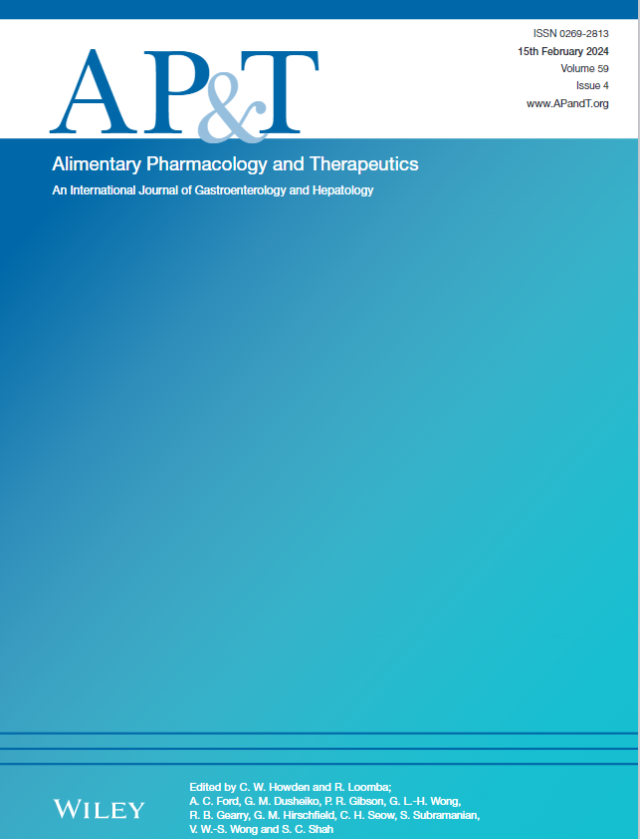Meta-Analysis: Utilisation of Hepatocellular Carcinoma Surveillance.
IF 6.7
1区 医学
Q1 GASTROENTEROLOGY & HEPATOLOGY
引用次数: 0
Abstract
BACKGROUND AND AIMS Major society guidelines recommend hepatocellular carcinoma (HCC) surveillance every 6 months with hepatic ultrasound. HCC surveillance is associated with early detection and improved survival but is underutilised. We aim to provide an updated assessment of HCC surveillance utilisation. METHODS Ovid MEDLINE and Embase were searched from inception until 30 November 2023 to identify studies reporting the proportion of people with either cirrhosis or chronic hepatitis B who underwent ultrasound-based HCC surveillance. The primary objective was to determine the utilisation of HCC surveillance. A meta-analysis of proportions was conducted using a generalised linear mixed model. RESULTS Forty-eight articles (1,275,349 individuals) met inclusion criteria. In at-risk individuals (cirrhosis or chronic hepatitis B), pooled utilisation of any HCC surveillance (n = 21 studies) was 54.45% (95% CI: 37.77-70.19), and utilisation of biannual surveillance (n = 7 studies) was 8.76% (95% CI: 2.46-26.79). Utilisation of any HCC surveillance was 53.37% (95% CI: 33.72-72.03) in patients with cirrhosis (n = 15 studies) and 66.43% (95% CI: 42.74-83.99) in patients with chronic hepatitis B (n = 12 studies), while utilisation of biannual surveillance was 10.20% (95% CI: 1.92-39.71) and 12.96% (95% CI: 0.02-99.09) respectively. Utilisation of surveillance did not improve over time. Pooled analysis of 40,497 individuals diagnosed with HCC (n = 27 studies) determined that the proportion of patients who had undergone prior screening or been diagnosed by surveillance was 36.07% (95% CI: 28.30-44.63). CONCLUSIONS Less than 10% of patients received the recommended biannual ultrasound scans for surveillance. These findings are concerning and call for greater awareness and collaboration between care providers and healthcare policymakers to improve surveillance utilisation.荟萃分析:肝细胞癌监测的应用。
背景和目的主要社会指南推荐每6个月肝超声监测肝细胞癌(HCC)。HCC监测与早期发现和提高生存率相关,但未得到充分利用。我们的目的是提供HCC监测应用的最新评估。方法检索sovid MEDLINE和Embase从建立到2023年11月30日,以确定报告肝硬化或慢性乙型肝炎患者接受基于超声的HCC监测的比例的研究。主要目的是确定HCC监测的使用情况。采用广义线性混合模型对比例进行了荟萃分析。结果48篇文献(1,275,349人)符合纳入标准。在高危人群(肝硬化或慢性乙型肝炎)中,任何HCC监测的总使用率(n = 21项研究)为54.45% (95% CI: 37.77-70.19),每年两次监测的使用率(n = 7项研究)为8.76% (95% CI: 2.46-26.79)。肝硬化患者(n = 15项研究)的HCC监测使用率为53.37% (95% CI: 33.72-72.03),慢性乙型肝炎患者(n = 12项研究)的HCC监测使用率为66.43% (95% CI: 42.74-83.99),而每年两次监测的使用率分别为10.20% (95% CI: 1.92-39.71)和12.96% (95% CI: 0.02-99.09)。监测的利用并没有随着时间的推移而改善。对40,497名确诊为HCC的患者(n = 27项研究)的汇总分析确定,接受过事先筛查或通过监测诊断的患者比例为36.07% (95% CI: 28.30-44.63)。结论只有不到10%的患者接受了推荐的每年两次的超声检查。这些发现令人担忧,并呼吁提高护理提供者和医疗保健决策者之间的意识和合作,以改善监测的利用。
本文章由计算机程序翻译,如有差异,请以英文原文为准。
求助全文
约1分钟内获得全文
求助全文
来源期刊
CiteScore
15.60
自引率
7.90%
发文量
527
审稿时长
3-6 weeks
期刊介绍:
Alimentary Pharmacology & Therapeutics is a global pharmacology journal focused on the impact of drugs on the human gastrointestinal and hepato-biliary systems. It covers a diverse range of topics, often with immediate clinical relevance to its readership.

 求助内容:
求助内容: 应助结果提醒方式:
应助结果提醒方式:


